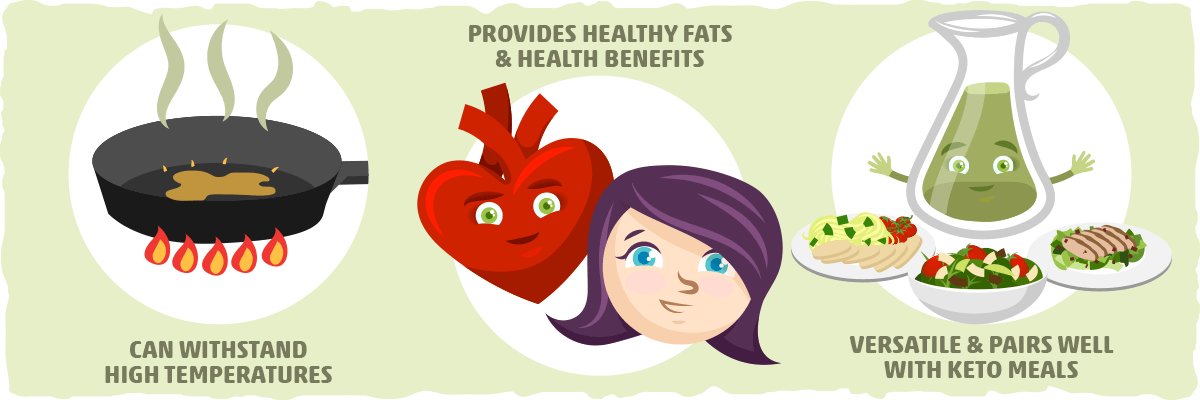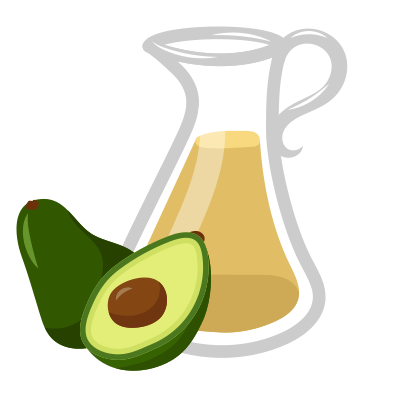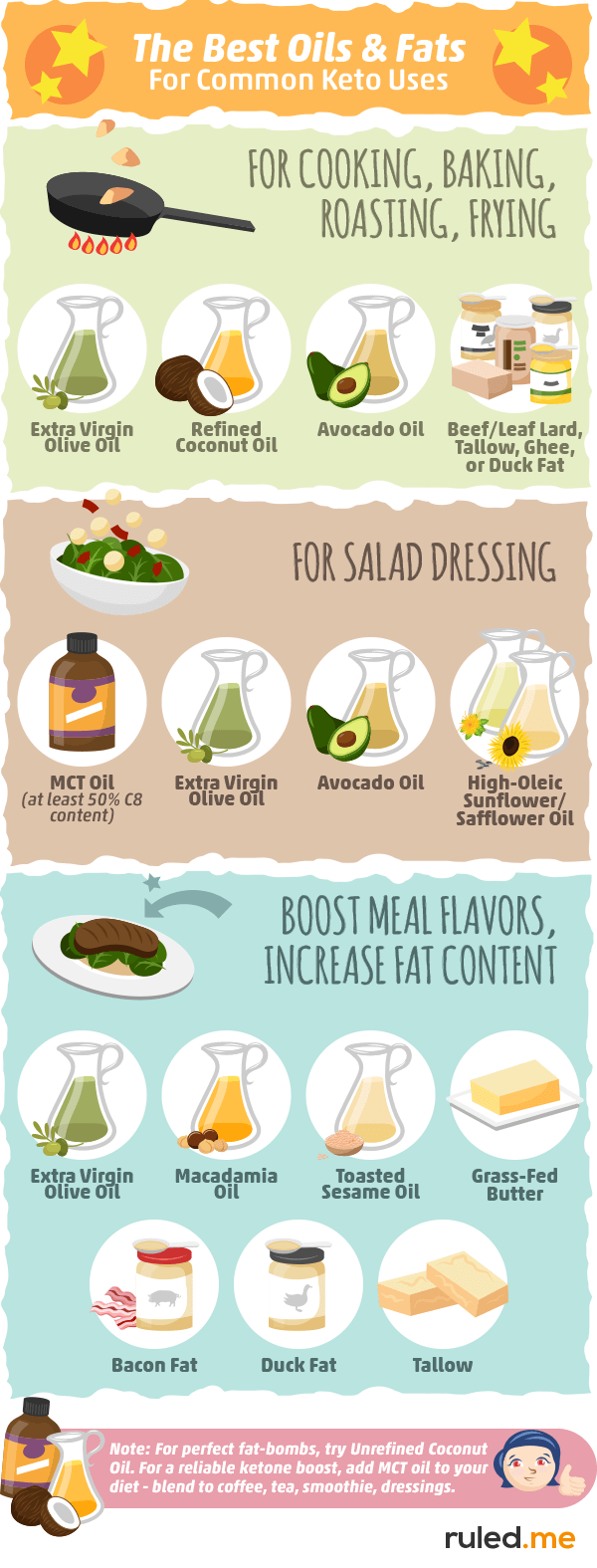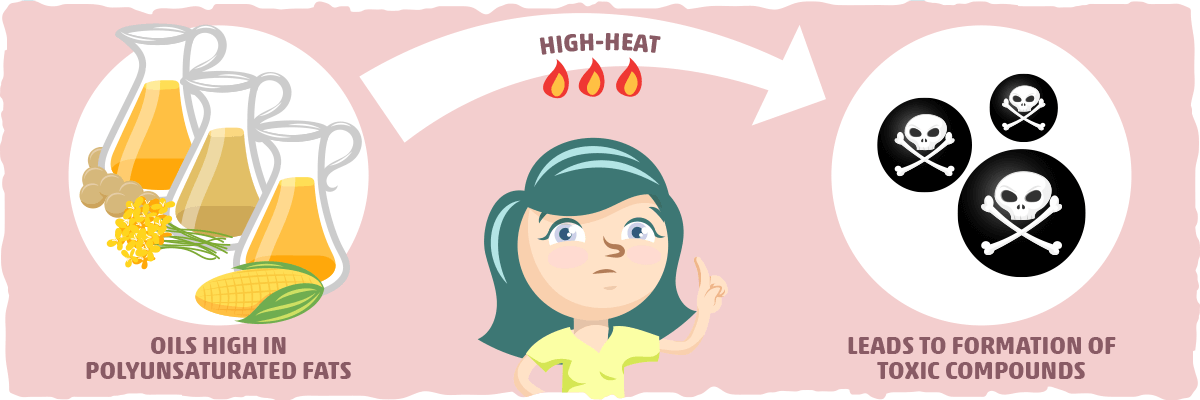Best Cooking Oil For Low Carb Diet
All plant-based oils have zero carbs and protein, making them the purest source of fat you can have on the keto diet. However, this doesn't mean that everything in the cooking oil aisle can be considered as a good "keto oil" for your low-carb lifestyle.
Though you can lose fat on keto regardless of what fats you consume, the oils you use will play a crucial role in ensuring optimal health, wellbeing, and sustained ketosis. Since fat will be your primary source of energy, choosing the right oils can be the deciding factor between a healthy vs. unhealthy ketogenic diet.
The options we recommend below should only be used in combination with high-fat, keto-friendly foods – even the healthiest oils should never be your primary source of calories on a keto diet. More specifically, it is best to use keto oils to add some extra fat to your low-carb meals via cooking, frying, baking, and drizzling. The majority of your calories should come from minimally-processed keto-friendly meats, seafood, cheese, low-carb vegetables, nuts, and seeds.
By using the right oils for the right reasons, you will be able to get the most out of the ketogenic diet's benefits.
The Best Keto Oils for the Ketogenic Diet: For Cooking, Frying, Dressing, etc.

The ideal oil for your keto lifestyle is one that has the following qualities:
- It can withstand high temperatures without breaking down into toxic by-products.
- It provides us with healthy fats and health benefits.
- It is versatile and pairs well with many keto meals.
When we look at oils from this perspective, extra virgin olive oil emerges as the best option in all three categories. The research on its health benefits and stability in cooking, as well as its ability to boost the flavor of virtually any keto meal is unsurpassed by other popular oils.
Along with that, there are several other great keto oils worth using as well. These include coconut oil, MCT oil, avocado oil, high-oleic sunflower/safflower oil, toasted sesame oil, and red palm oil. Let's take a closer look at each one of these oils, what to buy, and how to use them to boost your results.
For your convenience, here is a clickable list of the good keto oils we will learn about in this article:
- Extra virgin olive oil
- Coconut oil
- MCT oil
- Avocado oil
Other less common oils worth exploring:
- High-oleic sunflower/safflower oil
- Sesame oil
- Macadamia Oil
- Palm oil
- Animal fats (although not an oil, it's a fat that is used for cooking)
In the second half of this post, we will learn about the oils that are bad for keto:
- Which oils to avoid
- Why to avoid them
Extra Virgin Olive Oil: The Best of the Best
If you don't have extra virgin olive oil in your kitchen, I recommend getting some. The research studies on its health benefits and stability are quite impressive.
Despite the standard advice to avoid this oil for high-heat cooking, a recent study found extra virgin olive oil to be the most resistant to oxidation when used in frying and cooking tests. It even surpassed avocado oil, which is lauded for having the highest smoke point of any oil (we'll learn more about this later).
However, this doesn't mean every olive oil on the shelf will have these qualities. It is crucial that you only use 100% extra virgin olive oil and look for the freshest product possible since the oil tends to become rancid 12-14 months after pressing.

To ensure you are getting a high-quality oil, buy from this list of olive oil companies that have been tested for quality:
- Oleum Viride (~$0.82 per Fl Oz)
- California Olive Ranch (~$0.63 per Fl Oz)
- Kirkland Organic (~$0.33 per Fl Oz)
Other trustworthy brands that are a bit more expensive are California Olive Ranch, Cobram Estate, Lucini, Lucero (Ascolano), and McEvoy Ranch Organic.
According to studies on olive oil, these are the brands that failed to meet high-quality extra virgin olive oil standards: Bertolli, Carapelli, Colavita, Star, Pompeian, Filippo Berio, Mazzola, Mezzetta, Newman's Own, and Safeway.
Once you find high-quality extra virgin olive oil for your keto diet, it's time to experience its flavor to the fullest. Here are some of our favorite keto recipes featuring EVOO:
- Easy Keto Italian Plate
- Keto-friendly Cauliflower Pizza Crust
- Keto Hummus
Advantages of using extra virgin olive oil for keto:
- Packed with healthy monounsaturated fats and health-promoting polyphenols.
- Serves as the perfect keto salad dressing oil and adds an extra boost of flavor to keto recipes.
- Great for high-heat cooking, baking, and frying.
Disadvantages of using extra virgin olive oil for keto:
- Adds a particular flavor to food that may not be ideal for certain dishes and desserts.
- May be difficult to find a trustworthy and budget-friendly brand that produces fresh extra virgin oil.
Coconut Oil: Which One to Choose for Your Keto Needs?
The world of coconut oil can be confusing with seemingly endless variations of the same product. In general, there are only two types of coconut oil worth using for keto: refined and unrefined (unrefined includes "virgin" and "extra-virgin" products as well).
Refined coconut oil is odorless, flavorless, and typically the cheapest type of coconut oil. It also follows closely behind extra virgin olive oil in terms of baking and cooking stability.
On the other hand, unrefined, virgin, and extra virgin coconut oil products are generally more expensive (by a few cents per ounce) and have a distinct coconut aroma. This variety may also be a bit healthier since it is processed in a gentler fashion than refined oil.

However, unrefined coconut oil is not recommended for high-heat cooking because it contains more delicate compounds that are prone to oxidation.
Overall, the coconut oil that will be best for you depends on what you will use it for:
- If you are looking for a tasteless and multipurpose cooking oil, then refined coconut oil is the best option. Buy it in bulk and use it for cooking, baking, frying, and making fat bombs.
- If you already have a reliable cooking oil and enjoy the flavor of coconut, go with the unrefined (virgin or extra-virgin) coconut oil. These options are ideal for making keto desserts and fat bombs.
To give you a better idea of how you'd use each type of coconut oil on keto, here are some recipes that call for refined coconut oil:
- Nacho Steak Skillet
- Huevos Rancheros
And dessert recipes featuring unrefined coconut oil:
- Coconut Raspberry Slice
- Keto Chocolate Coconut Macaroon Cookies
Advantages of refined coconut oil for keto:
- Great for high-heat cooking/baking.
- Great for making keto desserts, chocolate, and fat bombs (if you don't like coconut flavor).
- Flavorless and odorless.
- Typically the cheapest variety of coconut oil.
- Helps promote ketosis.
Advantages of unrefined, virgin, and extra-virgin coconut oil for keto:
- Adds a pleasant coconutty taste to keto desserts and fat bombs.
- The perfect base for making keto chocolate and fat bombs.
- May be healthier than the refined option.
- Helps promote ketosis.
Disadvantages of unrefined, virgin, and extra-virgin coconut oil for keto:
- Should not be used for high-temperature cooking and baking.
- Typically a bit more expensive than refined coconut oil.
Disadvantages of each type of coconut oil for keto:
- Not ideal for keto smoothies, sauces, condiments, and dressings (use MCT oil instead).
MCT Oil: A Ketone Boosting Oil
Coconut oil is known as a ketosis-boosting oil because it contains a type of saturated fat that helps promote ketone production: medium chain triglycerides (MCTs). These are the fats that are extracted from coconut oil (or palm kernel oil) to create MCT oil.
Unfortunately, not all MCT oil products are made the same. When buying one, it is best to look for a product that consists of only caprylic acid (C8) and capric acid (C10). This combination has been found to increase ketone levels substantially more than coconut oil. This is our favorite brand of MCT Oil to buy (use coupon RULEDME for 15% off).
You may also come across products that solely consist of caprylic acid (C8), such as Brain Octane Oil. Though they justify their higher price tag with promises of higher ketone levels, the studies on these products only show a modest increase when compared to an MCT oil with 55% C8 and 35% C10.

However, the research does conclusively show that caprylic acid (C8) is the most ketogenic fatty acid commonly found in MCT supplements. Before you buy MCT oil to help promote ketosis, make sure the product you purchase has at least 50% caprylic acid (C8) in it.
If you'd like to learn more about MCT oil, its benefits, and how to use it, check out our comprehensive guide to MCTs.
Advantages of using MCT oil for keto:
- Increases ketone levels and relieves some keto flu symptoms.
- Great for keto smoothies, salad dressings, and ketoproof coffee.
Disadvantages of using MCT oil for keto:
- Should not be used at temperatures above 320 degrees Fahrenheit.
- Can cause short-term gastrointestinal symptoms for some.
Avocado Oil: Is it Worth the Extra Cost?
Avocado oil has a similar fatty acid profile to that of olive oil and is acclaimed as being the best oil for high-heat cooking (with an astonishingly high smoke point of ~520 degrees Fahrenheit).
However, despite having a higher smoke point than extra virgin olive oil, head-to-head testing found extra virgin olive oil and coconut oil to be slightly more resistant to oxidation and the formation of toxic compounds during high-heat cooking tasks.
Given the higher price point of avocado oil, it may be best to stick with refined coconut oil and extra virgin olive oil for your cooking and baking needs.

That being said, if you prefer avocado oil, here are some examples of how you'd use it on keto:
- Keto Nutella
- Keto Egg Roll in a Bowl
- Keto Asparagus, Egg, and Bacon Salad
Advantages of using avocado oil for keto:
- Provides us with plenty of heart-healthy monounsaturated fats.
- Has a slightly nutty and buttery flavor, making it great for salads dressings, sauces, keto desserts, and drizzling on your meals.
Disadvantages of using avocado oil for keto:
- Costlier than other common oils.
- Not as stable as extra virgin olive oil and coconut oil during high-heat cooking.
High Oleic Sunflower and High Oleic Safflower Oil
With a similar fatty acid profile to that of olive oil, these two high-oleic oils are also great options for keto. They have a relatively neutral taste and can be used as a replacement for avocado oil or olive oil in most cases.
Please note: When purchasing either one of these oils, make sure it is labeled as "high oleic." The high-oleic oils mostly consist of healthy, heat-stable fats, which make them a great keto cooking oil.
In contrast, regular sunflower and safflower oils should be avoided because they are filled with delicate fatty acids that oxidize quickly and increase inflammation.

Advantages of these high-oleic oils for keto:
- Packed with heart-healthy fats.
- Can be used as a replacement for avocado oil or olive oil.
- Tends to cost less per ounce than avocado oil and extra virgin olive oil.
Disadvantages of these high-oleic oils for keto:
- Its cooking stability has not been studied in comparison with coconut oil, avocado oil, or extra virgin olive oil.
Macadamia Oil
This oil is a real treat. It has a rich, buttery flavor that can take your keto desserts and baked goods to another level. You can fry, cook, and saute with it as well.
On top of pleasing the palate, macadamia oil also supports optimal health by providing us with a potent dose of antioxidants and more monounsaturated fats than olive oil.
It can be very expensive to purchase compared to other keto oils that have a better fat profile, so it may be worth avoiding this one for the cost alone. Besides this, there's also not been many studies on the stability of this oil since it's relatively uncommon to find in grocery stores.

Advantages of using macadamia oil for keto:
- Packed with heart-healthy fats and antioxidants.
- Imparts are rich, buttery flavor to your keto recipe.
- Can be used as a replacement for avocado oil or olive oil.
Disadvantages of using macadamia oil:
- Tends to be more expensive than other keto oils.
- Its cooking stability has not been studied in comparison with coconut oil, avocado oil, or extra virgin olive oil.
Sesame Oil: Is it Good for Keto?
Sesame oil is only suitable for keto if you consume it sparingly and don't expose it to high heat. This is due to the fact that it mostly consists of omega-6 fatty acids, which rapidly degrade during cooking and can promote chronic inflammation in high doses.
The reason why I included sesame oil in the "good oils" category is because of the wonderful flavor it adds to Chinese- and Japanese-inspired keto dishes.
A drizzle of toasted sesame oil may be all you need to bring your dinner to life. To get an idea of how to use this oil for keto, try making these popular dishes:
- Sesame Almond Zoodle Bowl
- Keto Crispy Sesame Beef
- Keto General Tso's Chicken

Since you will only be using this oil for its distinct flavor, stick with toasted sesame oil (which is darker in color than light sesame oil). Light sesame oil is not worth purchasing for keto since it has a milder flavor.
Advantages of using toasted sesame oil for keto:
- Adds a satisfying flavor to Chinese- and Japanese-inspired keto dishes.
- A small amount is usually all you need.
Disadvantages of toasted sesame oil for keto:
- High omega-6 content.
- Should not be used for cooking.
- Not an optimal oil for increasing the fat content of a meal.
Palm Oil: Is it Bad for Keto?
As long as you buy the right product, palm oil can be a great addition to the keto diet. Since it is often produced in a way that devastates the rainforest and its wildlife, we must pay close attention to what palm oil we consume.
In general, the healthiest palm oil for you and the environment is Red Palm Oil that is Certified Sustainable Palm Oil (CSPO).
This palm oil is produced in a way that aims to reverse the damage done by palm oil plantations while maximizing the quality of the oil.
CSPO Red palm oil is full of healthy fats, is an excellent source of vitamins A & E, and can be used for high-heat cooking, sauteing, and frying.

However, it has a bold, paprika-like flavor, so it won't pair well with desserts, sweets, and baked goods. You'll find it tastes best when used as a cooking oil for tomato-based dishes and spicy foods.
Advantages of using CSPO-certified red palm oil:
- Excellent source of healthy fats, vitamin A, vitamin E, and phytonutrients.
- Adds a bold, paprika-like flavor that pairs well with tomato-based dishes and spicy foods.
- Can be used to replace coconut oil as a cooking oil for savory meals.
Disadvantages of using CSPO-certified red palm oil:
- Tends to be more expensive than other keto oils.
- Not suitable for keto desserts and sweets.
Key Takeaway: The Top 3 Oils for the Keto Diet
To simplify your choices even further, we decided to include a list of our top three recommended oils for keto. We find that these three are the best of the best in terms of price, versatility, and health benefits:
- Extra virgin olive oil — This is arguably the best oil for cooking, drizzling, and using in keto dressings. It pairs well with virtually all savory keto recipes and is filled with health-promoting fats and antioxidants.
- Refined coconut oil — The refined variety of coconut oil can be used as a high-heat cooking oil, the base for keto fat bombs, and as the primary fat in both sweet and savory keto recipes. Keto dieters often buy this oil in bulk because of how versatile it is.
- MCT oil — Though it shouldn't be exposed to high heat, MCT oil still took the third spot because of its versatility and ability to increase ketone levels. Whenever you need a quick energy boost, just drizzle some on your meal or add it to your keto smoothie, salad dressing, or ketoproof coffee. MCT oil is one of the easiest and healthiest ways to add extra fat to your keto diet.
Although these are the top 3 keto oils, it is not necessary to have each one in your kitchen. Technically, all you'll need is a reliable oil for high-heat cooking and dressings/drizzling (like EVOO).
If keto-friendly sweets are a part of your diet, then refined coconut oil will be your go-to oil since it can be used in keto desserts, entrees, and fat bombs.
That being said, plant-based oils won't be your only option for keto cooking and baking: You can use your favorite animal fats as well.
Animal Fats: Are Lard, Tallow, and Duck Fat Good on Keto?

Though they are not classified as oils, animal fats are composed of the same fatty acids as plant-based oils. The main difference between the two is that animal fats consist of more saturated fat, which makes them solid at room temperature and heat stable.
Butter and Ghee
When cooked at low-to-medium heat, butter can provide a satisfying flavor and creamy quality to the meal that no oil or fat can mimic. However, if you let the pan get too hot, the proteins and milk sugars in the butter can start to burn.
Clarified butter, also known as ghee, is essentially butter with its protein and milk sugars filtered out. This makes it much better for high-heat cooking, minimizing the risk of burning without losing that satisfying buttery flavor.
Whether you decide to get butter, ghee, or both, the healthiest and most flavorful option will come from pasture-raised, grass-fed cows.
Lard: Should You Use Bacon Fat or Leaf Lard?
Lard is one of the cheapest cooking fats for keto because you can make it yourself. Next time you make bacon, put those delicious slices of heaven in the oven as it is preheating. This will help you render out as much fat as possible from the bacon.
Once the bacon is cooked to the desired level of crispness, simply remove it from the tray and filter the rendered lard through a fine-mesh strainer.
Feel free to use your homemade lard for any of your cooking needs, especially when you want to add a bacon flavor to your keto meal. The leftover bacon fat will keep in the fridge for up to a year.
On the other hand, if you are looking for a shortening or baking fat that doesn't turn your keto cupcakes into bacony bread, leaf lard will be the better option. Though it is much more expensive, this type of lard is ideal for making baked goods flaky and moist without adding any pork flavor to them.
Both leaf lard and bacon fat are good for high-heat cooking. The healthiest option, for both types, will be derived from pasture-raised pork. Note: some store-bought options of lard will be hydrogenated – you will want to avoid these.
Tallow
Like lard but rendered from beef (or mutton), tallow has a rich and buttery flavor that makes virtually any keto meal taste better.
It is often used for high-temperature cooking methods like frying and roasting. For example, you can coat your keto vegetables with tallow before roasting for an added touch of rich flavor.
If you'd like to add a subtle lamb-like flavor to your meals, try using lamb or mutton tallow instead. This option will pair well with any beef or lamb dish.
When purchasing tallow, opt for a product that is derived from 100% pasture-raised, grass-fed animals.
Duck Fat
With more healthy fat and flavor than chicken, duck is the perfect poultry for the keto diet. Even its fatty acid composition makes duck fat much better for cooking than chicken fat.
To experience the uniquely rich flavor of duck, you can either buy pasture-raised duck fat or save the leftover fat from making a roasted duck leg (or duck confit). Use the fat to pan fry or roast your favorite meats and veggies — or melt it on top of your keto meal to boost its healthy fat content.
Serving Suggestions: How to Add Keto Oils and Fats to Your Diet for Optimal Health and Fat Loss
Although the fats/oils mentioned above are great for the keto diet, it is surprisingly easy to overeat them and counteract your keto progress. In fact, adding too much pure fat/oil your meals is a common culprit of weight loss stalls and impaired cholesterol levels.
For optimal health and fat loss, most of your fat intake on keto should be coming from high-fat, minimally processed foods such as fatty cuts of meat, fish, eggs, full-fat cheese, nuts, seeds, and avocado. The recommended oils/fats in this article should only be used as a way to supplement your fat intake.
For most people, this means consuming no more than three or four tablespoons of pure fat/oil per day. The exact amount, however, will vary from person to person, depending on their keto macro needs.
To get a better estimate of what your daily fat intake should be, use our keto calculator. This will show you how many grams of fat you can eat and help you determine when you are adding too much extra fat/oil to your diet.
Practical Takeaways: The Best Oils and Fats for Common Keto Uses
Let's look at these oils for a more practical perspective to find out which are best for specific purposes:

For cooking, baking, roasting, and frying, stick with these four options:
- Extra virgin olive oil
- Refined coconut oil
- Avocado oil
- Pasture-raised lard (leaf for baking), tallow, ghee, or duck fat
Other good oils for this purpose include high-oleic sunflower/safflower oil, macadamia oil, and CSPO-certified red palm oil.
For salad dressing, these are the best options:
- MCT oil (with at least 50% C8 content to promote ketosis)
- Extra virgin olive oil
- Avocado oil
- High-oleic sunflower/safflower oil
To help boost the flavor and fat content of your meal, add these flavorful fats and oils on top:
- Extra virgin olive oil
- Macadamia oil
- Toasted sesame oil
- Grass-fed butter
- Bacon fat
- Duck fat
- Tallow
If you are looking for the perfect oil for fat bombs, try using unrefined coconut oil.
And finally, for a reliable ketone boost, add MCT oil to your diet. You can do this by blending it into your coffee, tea, smoothie, or dressing — or by following the other recommendations in our guide to MCTs.
If you'd like to know the smoke points of all of the oils we recommend, here's a quick breakdown:
| Oil Type | Smoke Point (°F) | Smoke Point (°C) |
| Extra virgin olive oil | 375 | 190 |
| Refined coconut oil | 450 | 232 |
| Avocado oil | 520 | 270 |
| Pasture-raised lard | 370 | 188 |
| Tallow | 400 | 204 |
| Ghee | 450 | 232 |
| Duck fat | 375 | 190 |
| High-oleic sunflower/safflower oil | 486 | 252 |
| Macadamia oil | 410 | 210 |
| CSPO-certified red palm oil | 455 | 235 |
| MCT oil | 320 | 160 |
| Toasted sesame oil | 350 | 177 |
| Grass-fed butter | 302 | 150 |
Bad Oils for Keto: A List of What to Avoid
In general, it is best to limit your consumption of any product that has one of the following characteristics:
- Consists of high amounts of polyunsaturated fats
- Contains any partially and/or fully hydrogenated oils
The most common oils that fit into this category are:
- Margarine (and any other products that contain partially or fully hydrogenated oils)
- Corn oil
- Soybean oil
- Safflower oil*
- Sunflower oil*
- Cottonseed oil
- Canola oil
- Vegetable oil
- Grapeseed oil
- Rice bran oil
*The high-oleic version of this oil is good for keto, but the regular variety is not.
Though the common consensus is to avoid hydrogenated oils, there is still a lot of confusion in the keto community about the other oils on this list.
Canola oil, in particular, is often recommended for cooking and frying due to its relatively low cost and high smoke point. However, recent research on this and other common cooking oils suggests that we should consider more than just the smoke point.
Why are Soybean, Corn, and Canola Oil Bad for Keto?

Throughout this article, I've mentioned the studies conducted on the stability of common keto oils like extra virgin olive oil, avocado oil, and coconut oil. Despite the fact that avocado oil has the highest smoke point of these three, it was the least stable (of the three) when exposed to high-heat cooking methods.
A similar pattern emerged for canola oil as well. Despite having a similar smoke point as extra virgin olive oil, it fared far worse. The delicate fats found in canola oil quickly broke down into toxic by-products, while extra virgin olive oil had the lowest level of these toxins.
The same held true for other vegetable/seed oils with high amounts of polyunsaturated fats as well, including sunflower oil, rice bran oil, and grapeseed oil. This leads us to the main reason why soybean, corn, and canola oil are so bad for keto: They contain a high amount of polyunsaturated fats.
Due to their chemical structure (i.e., having two or more carbon-to-carbon double bonds), these fats are vulnerable to breaking down into toxic compounds after being exposed to too much heat, light, or air.
In contrast, saturated and monounsaturated fats are much more stable. When we consider the fact that olive oil, avocado oil, and coconut oil all contain more than 80% of these fats (and less than 20% of polyunsaturated fats), it's not surprising that these oils held up strong to heat exposure.
Overall, it is best to limit your consumption of oils that are high in polyunsaturated fats, even in their unheated form. Though polyunsaturated fats are a healthy part of the keto diet, you will get more than enough when you consume minimally-processed keto foods.
The Bigger Picture: Practical Principles for Oils, Fats, and a Healthy Keto Diet

Now that you know the dos and don'ts when it comes to oils, let's apply what we know to the broader context of your keto lifestyle with these five fat intake principles:
- Get most of your calories from minimally processed high-fat foods. Only use pure fats/oils to supplement your meal rather than relying on them as your primary fat source. Take a look at our keto food list if you'd like to see all of the healthy keto-friendly options you can add to your diet.
- Monounsaturated and saturated fats should represent the majority of your fat intake. To help you find out how much this means for you, use our keto calculator and follow our guidelines for optimal fat intake on the keto diet.
- Avoid all partially/fully hydrogenated oils and refined oils that are high in polyunsaturated fats. The only exception to this rule is toasted sesame oil, which should only be used sparingly as a flavor enhancer.
- Only cook with fats/oils that have more than 80% of monounsaturated + saturated fats. Extra virgin olive oil, avocado oil, refined coconut oil, tallow, lard, ghee, and duck fat are the best options for cooking on keto.
- Meet your needs for polyunsaturated fats (like omega-3s and omega-6s) with whole foods. Since you'll be getting plenty of omega-6s from eggs, meat, dairy, nuts, seeds, and vegetables, the only polyunsaturated fats you may need to consume more of are DHA and EPA. For specific recommendations, check out our article on omega-3 fatty acids.
By applying these principles, you'll be able to eat the right types of fat in the right amounts to optimize your diet for success.
That being said, If you need some help with implementing these keto guidelines, we have plenty of resources that will get you on the right track:
- A Ketogenic Diet Guide for Beginners
- Our 14-day meal plan — One month of keto meals mapped out for you
Sources
- The Types of Fat: A Comprehensive Look at Good vs. Bad Fats — Ruled.me
- Chapter 4 – Oxidative Stability and Shelf Life of Vegetable Oils — ScienceDirect
- Evaluation of Chemical and Physical Changes in Different Commercial Oils during Heating — ACTA Scientific Nutritional Health
- Cooking with Extra Virgin Olive Oil — ACNEM Journal
- Molecular mechanisms of inflammation. Anti-inflammatory benefits of virgin olive oil and the phenolic compound oleocanthal. — NCBI
- Monounsaturated Fatty Acids Impede Inflammation Partially Through Activation of AMPK — The Faseb Journal
- Plasma Ketone and Medium Chain Fatty Acid Response in Humans Consuming Different Medium Chain Triglycerides During a Metabolic Study Day — NCBI
Best Cooking Oil For Low Carb Diet
Source: https://www.ruled.me/best-and-worst-oils-keto-diet/







Tidak ada komentar:
Posting Komentar